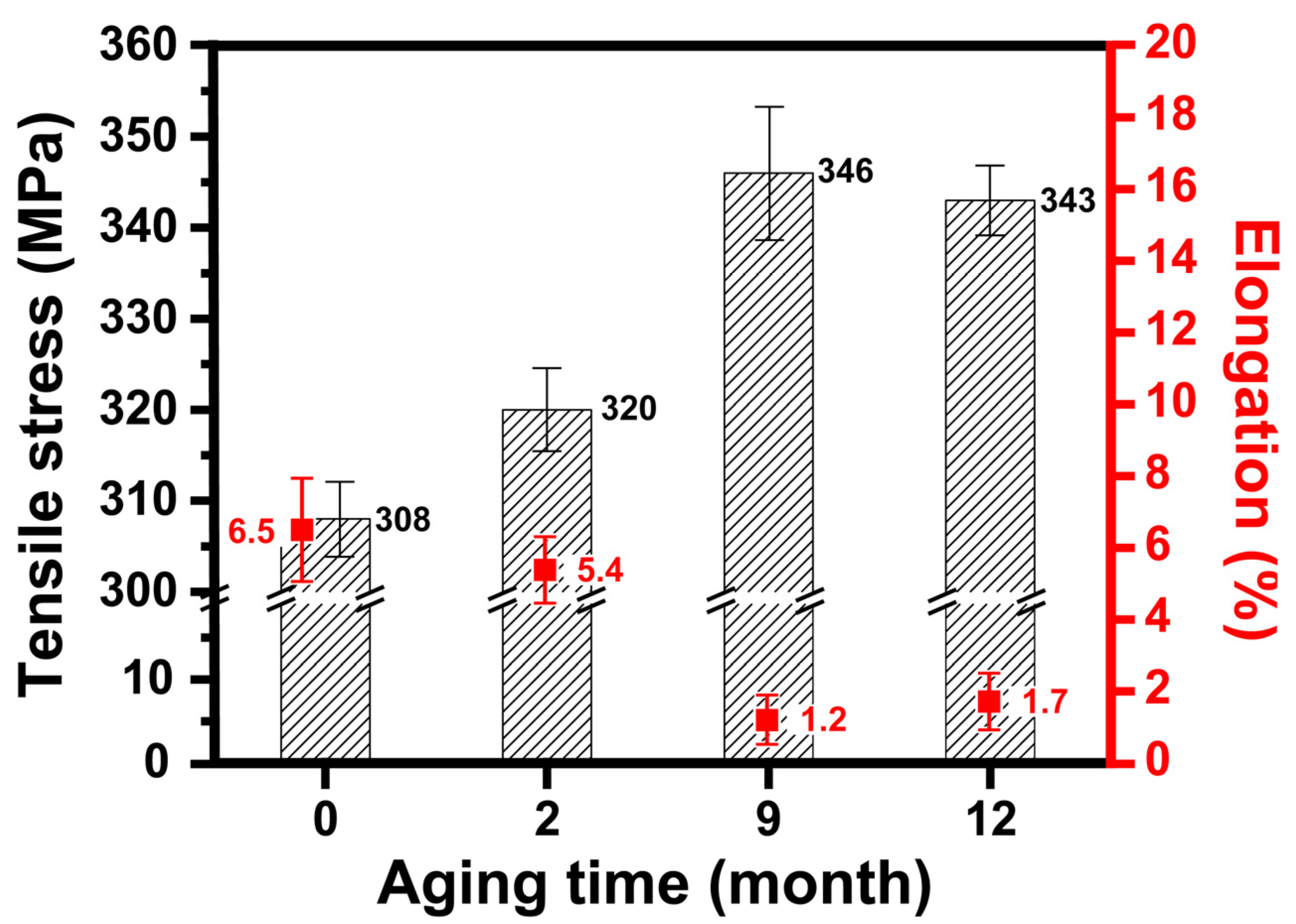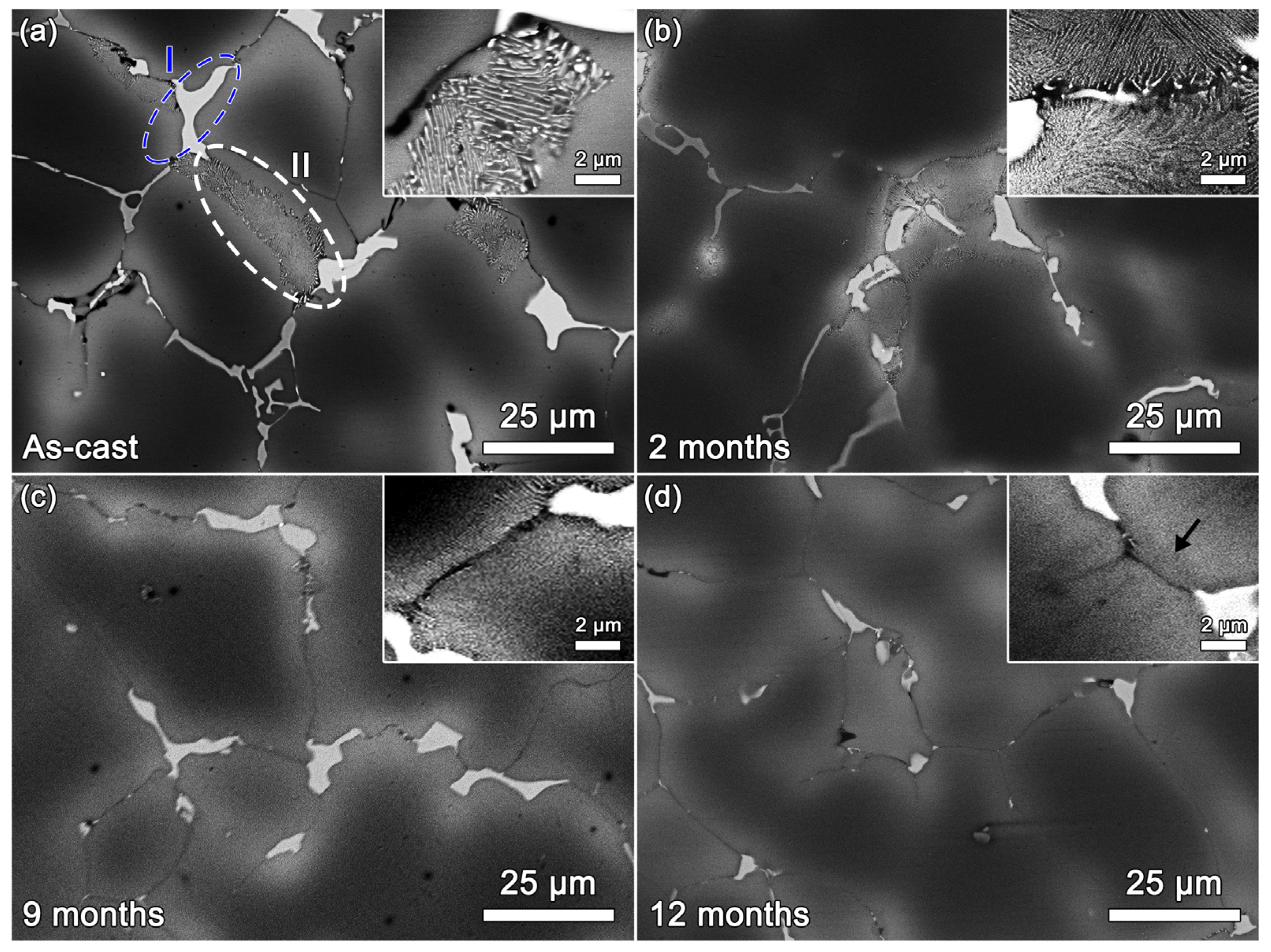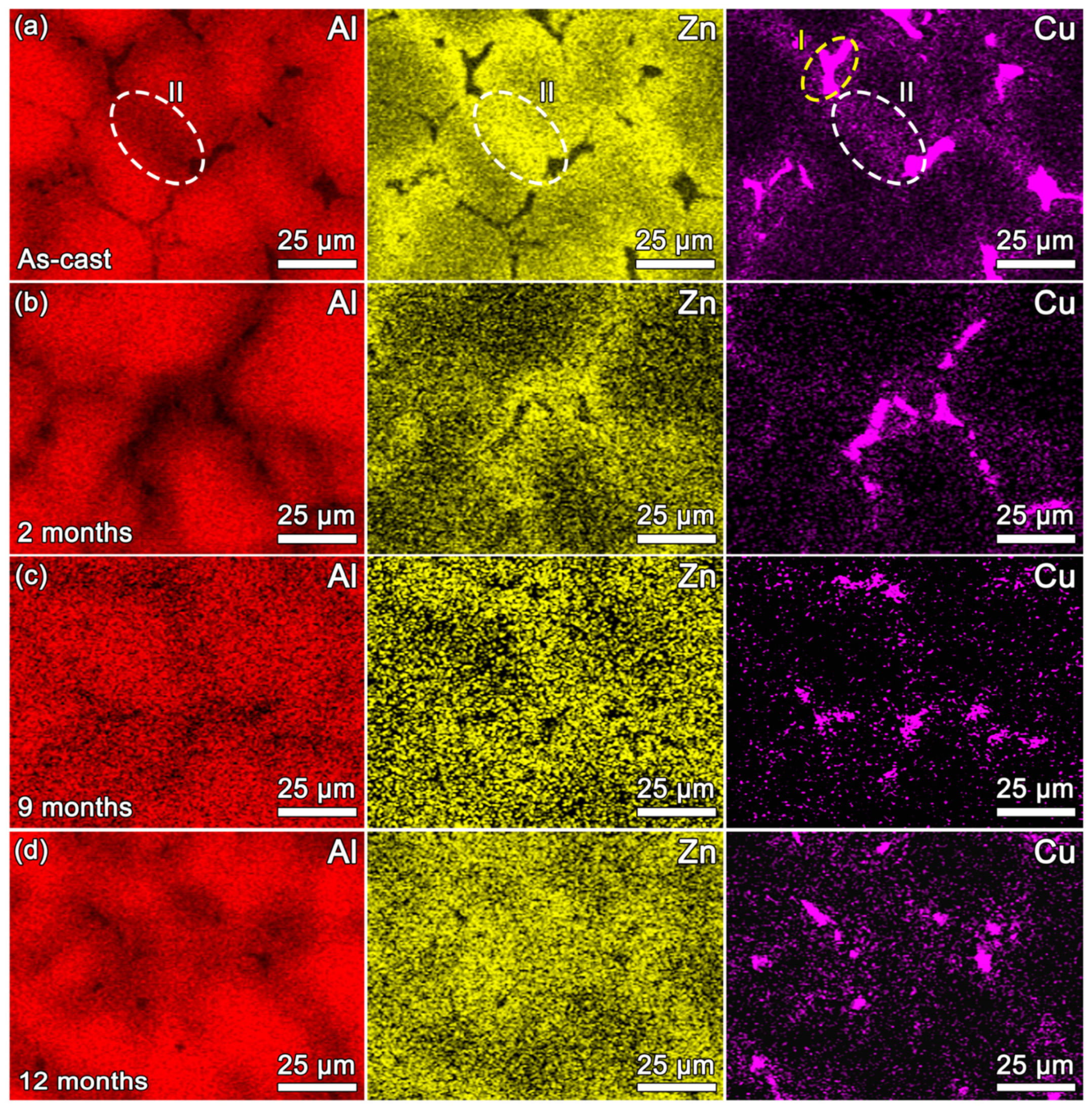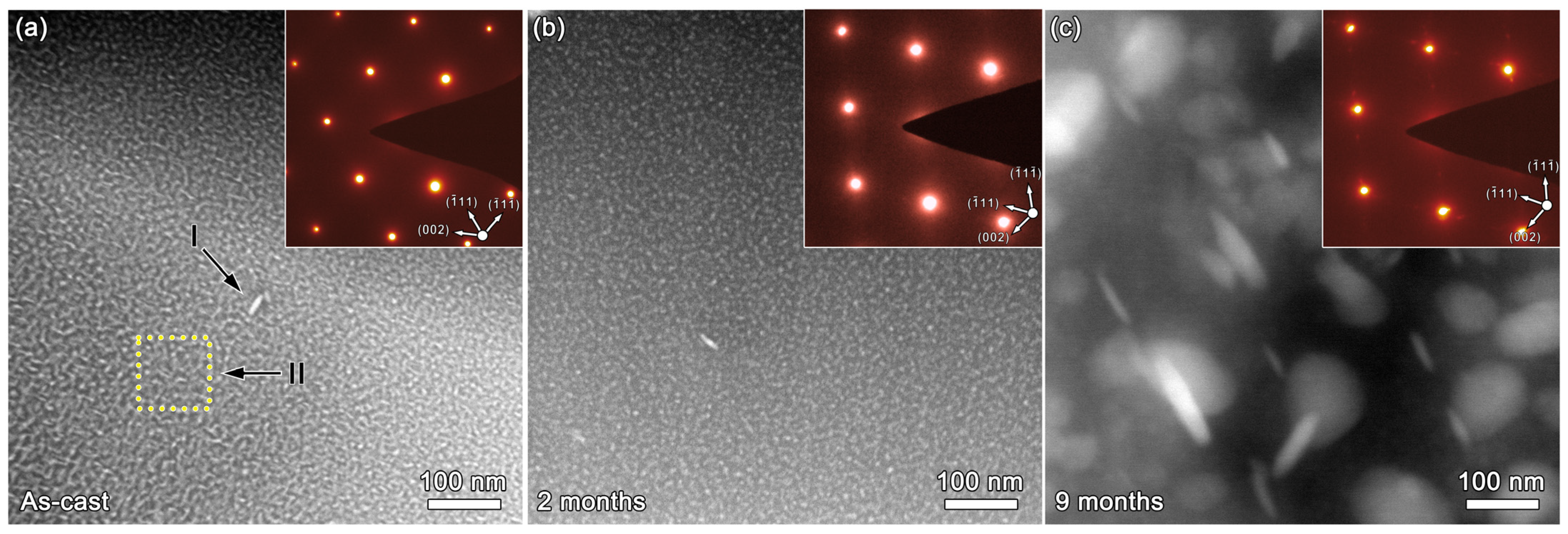Natural Aging Effect of Al-20Zn-3Cu Alloy on Mechanical Properties and Its Relation to Microstructural Change
Abstract
:1. Introduction
2. Experimental Procedures
3. Results and Discussion
4. Conclusions
Author Contributions
Funding
Institutional Review Board Statement
Informed Consent Statement
Data Availability Statement
Conflicts of Interest
References
- Wenlong, S.; Xiaokai, C.; Lu, W. Analysis of energy saving and emission reduction of vehicles using light weight materials. Energy Procedia 2016, 88, 889–893. [Google Scholar] [CrossRef] [Green Version]
- Long, R.S.; Boettcher, E.; Crawford, D. Current and future uses of aluminum in the automotive industry. JOM 2017, 69, 2635–2639. [Google Scholar] [CrossRef]
- Bandivadekar, A.; Bodek, K.; Cheah, L.; Evans, C.; Groode, T.; Heywood, J.; Kasseris, E.; Kromer, M.; Weiss, M. On the Road in 2035: Reducing Transportation’s Petroleum Consumption and GHG Emissions; Massachusetts Institute of Technology: Cambridge, MA, USA, 2008. [Google Scholar]
- Yılmaz, T.G.; Tüfekçi, M.; Karpat, F. A study of lightweight door hinges of commercial vehicles using aluminum instead of steel for sustainable transportation. Sustainability 2017, 9, 1661. [Google Scholar] [CrossRef] [Green Version]
- Kaufman, J.G.; Rooy, E.L. Aluminum Alloy Castings; ASM International: Geauga, OH, USA, 2004. [Google Scholar]
- Shin, J.; Kim, T.; Kim, D.E.; Kim, D.; Kim, K. Castability and mechanical properties of new 7xxx aluminum alloys for automotive chassis/body applications. J. Alloys Compd. 2017, 698, 577–590. [Google Scholar] [CrossRef]
- Okayasu, M.; Ohkura, Y.; Takeuchi, S.; Takasu, S.; Ohfuji, H.; Shiraishi, T. A study of the mechanical properties of an Al–Si–Cu alloy (ADC12) produced by various casting processes. Mater. Sci. Eng. A 2012, 543, 185–192. [Google Scholar] [CrossRef]
- Hu, X.; Jiang, F.; Ai, F.; Yan, H. Effects of rare earth Er additions on microstructure development and mechanical properties of die-cast ADC12 aluminum alloy. J. Alloys Compd. 2012, 538, 21–27. [Google Scholar] [CrossRef]
- Zhao, H.D.; Wang, F.; Li, Y.Y.; Xia, W. Experimental and numerical analysis of gas entrapment defects in plate ADC12 die castings. J. Mater. Process. Technol. 2009, 209, 4537–4542. [Google Scholar] [CrossRef]
- Hangai, Y.; Kamada, H.; Utsunomiya, T.; Kitahara, S.; Kuwazuru, O.; Yoshikawa, N. Tensile properties and fracture behavior of aluminum alloy foam fabricated from die castings without using blowing agent by friction stir processing route. Materials 2014, 7, 2382–2394. [Google Scholar] [CrossRef] [Green Version]
- Singh, H.; Kumar, S.; Kumar, D.; Srivastav, M.; Kumar, R.; Jain, J.; Chouhan, A.; Khatri, O.P. Reinforcing the Near Eutectic Aluminum–Silicon Alloy with Graphene: An Approach toward Self-Lubricating Composite. Adv. Eng. Mater. 2021, 23, 2000910. [Google Scholar] [CrossRef]
- Okayasu, M.; Sato, R.; Takasu, S.; Niikura, A.; Shiraishi, T. Mechanical properties of AlSiCu alloys produced by the twin rolled continuous casting process. Mater. Sci. Eng. A 2012, 534, 614–623. [Google Scholar] [CrossRef]
- Khalifa, W.; Tsunekawa, Y.; Okumiya, M. Effect of ultrasonic treatment on the Fe-intermetallic phases in ADC12 die cast alloy. J. Mater. Process. Technol. 2010, 210, 2178–2187. [Google Scholar] [CrossRef]
- Chen, Y.; Liu, C.Y.; Ma, Z.Y.; Huang, H.F.; Peng, Y.H.; Hou, Y.F. Effect of Sc addition on the microstructure, mechanical properties, and damping capacity of Al-20Zn alloy. Mater. Charact. 2019, 157, 109892. [Google Scholar] [CrossRef]
- Jiang, H.J.; Liu, C.Y.; Chen, Y.; Yang, Z.X.; Huang, H.F.; Wei, L.L.; Li, Y.B.; Qi, H.Q. Evaluation of microstructure, damping capacity and mechanical properties of Al-35Zn and Al-35Zn-0.5Sc alloys. J. Alloys Compd. 2018, 739, 114–121. [Google Scholar] [CrossRef]
- Shin, S.S.; Lim, K.M.; Park, I.M. Effects of high Zn content on the microstructure and mechanical properties of Al-Zn-Cu gravity-cast alloys. Mater. Sci. Eng. A 2017, 679, 340–349. [Google Scholar] [CrossRef]
- Krajewski, W.K.; Greer, A.L.; Buraś, J.; Piwowarski, G.; Krajewski, P.K. New developments of high-zinc Al-Zn-Cu-Mn cast alloys. Mater. Today Proc. 2019, 10, 306–311. [Google Scholar] [CrossRef]
- Murray, J.L. The Al-Zn (aluminum-zinc) system. Bull. Alloy Phase Diagr. 1983, 4, 55–73. [Google Scholar] [CrossRef]
- Shin, S.S.; Won, S.J.; So, H.; Lee, S.K.; Kim, K.H. High-Strength Al-Zn-Cu-Based Alloy Synthesized by High-Pressure Die-Casting Method. Metall. Mater. Trans. A 2020, 51, 6630–6639. [Google Scholar] [CrossRef]
- Chinh, N.Q.; Lendvai, J.; Ping, D.H.; Hono, K. The effect of Cu on mechanical and precipitation properties of Al–Zn–Mg alloys. J. Alloys Compd. 2004, 378, 52–60. [Google Scholar] [CrossRef]
- Alemdağ, Y.; Savaşkan, T. Mechanical and tribological properties of Al–40Zn–Cu alloys. Tribol. Int. 2009, 42, 176–182. [Google Scholar] [CrossRef]
- Skoko, Z.; Popović, S.; Štefanić, G. Microstructure of Al-Zn and Zn-Al Alloys. Croat. Chem. Acta 2009, 82, 405–419. [Google Scholar]
- Krajewski, W.K.; Buraś, J.; Krajewski, P.K.; Greer, A.L.; Faerber, K.; Schumacher, P. New developments of Al-Zn cast alloys. Mater. Today Proc. 2015, 2, 4978–4983. [Google Scholar] [CrossRef]
- Zhou, W.B.; Teng, G.B.; Liu, C.Y.; Qi, H.Q.; Huang, H.F.; Chen, Y.; Jiang, H.J. Microstructures and Mechanical Properties of Binary Al-Zn Alloys Fabricated by Casting and Heat Treatment. J. Mater. Eng. Perform. 2017, 26, 3977–3982. [Google Scholar] [CrossRef]
- Guo, M.X.; Zhang, Y.; Zhang, X.K.; Zhang, J.S.; Zhuang, L.Z. Non-isothermal precipitation behaviors of Al-Mg-Si-Cu alloys with different Zn contents. Mater. Sci. Eng. A 2016, 669, 20–32. [Google Scholar] [CrossRef]
- Zhu, S.; Li, Z.H.; Yan, L.Z.; Li, X.W.; Huang, S.H.; Yan, H.W.; Zhang, Y.G.; Xiong, B.Q. Natural aging behavior in pre-aged Al-Mg-Si-Cu alloys with and without Zn addition. J. Alloys Compd. 2019, 773, 496–502. [Google Scholar] [CrossRef]
- Cao, L.F.; Rometsch, P.A.; Couper, M.J. Clustering behaviour in an Al-Mg-Si-Cu alloy during natural ageing and subsequent under-ageing. Mater. Sci. Eng. A 2013, 559, 257–261. [Google Scholar] [CrossRef]
- ASTME. Standard Test Methods for Tension Testing of Metallic Materials; ASTME: West Conshohocken, PA, USA, 2001. [Google Scholar]
- Kallien, L.H.; Leis, W. Ageing of zink alloys. Giess. Incl. CD ROM 2011, 63, 2. [Google Scholar]
- Park, M.-J.; So, H.; Kang, L.; Byeon, J.-W.; Kim, K.-H. The relation between mechanical properties and microstructural evolution induced by Sc microalloying in Al-20Zn-3Cu alloy. J. Alloys Compd. 2021, 889, 161719. [Google Scholar] [CrossRef]





| Alloy | Zn | Cu | Ti | Zr | Fe | Si | Al |
|---|---|---|---|---|---|---|---|
| Al-20Zn-3Cu | 20 | 3.0 | 0.1 | 0.1 | 0.5 | 0.4 | Bal. |
Publisher’s Note: MDPI stays neutral with regard to jurisdictional claims in published maps and institutional affiliations. |
© 2021 by the authors. Licensee MDPI, Basel, Switzerland. This article is an open access article distributed under the terms and conditions of the Creative Commons Attribution (CC BY) license (https://creativecommons.org/licenses/by/4.0/).
Share and Cite
Park, M.-J.; So, H.; Kim, K.-H.; Byeon, J.-W.; Kang, L. Natural Aging Effect of Al-20Zn-3Cu Alloy on Mechanical Properties and Its Relation to Microstructural Change. Metals 2021, 11, 1485. https://doi.org/10.3390/met11091485
Park M-J, So H, Kim K-H, Byeon J-W, Kang L. Natural Aging Effect of Al-20Zn-3Cu Alloy on Mechanical Properties and Its Relation to Microstructural Change. Metals. 2021; 11(9):1485. https://doi.org/10.3390/met11091485
Chicago/Turabian StylePark, Min-Jung, Hyeongsub So, Kyou-Hyun Kim, Jai-Won Byeon, and Leeseung Kang. 2021. "Natural Aging Effect of Al-20Zn-3Cu Alloy on Mechanical Properties and Its Relation to Microstructural Change" Metals 11, no. 9: 1485. https://doi.org/10.3390/met11091485
APA StylePark, M.-J., So, H., Kim, K.-H., Byeon, J.-W., & Kang, L. (2021). Natural Aging Effect of Al-20Zn-3Cu Alloy on Mechanical Properties and Its Relation to Microstructural Change. Metals, 11(9), 1485. https://doi.org/10.3390/met11091485






